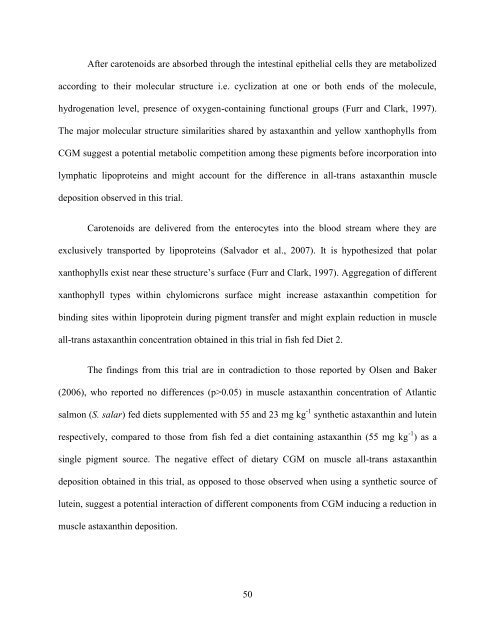Pigment Reduction in Corn Gluten Meal and Its Effects on Muscle ...
Pigment Reduction in Corn Gluten Meal and Its Effects on Muscle ...
Pigment Reduction in Corn Gluten Meal and Its Effects on Muscle ...
Create successful ePaper yourself
Turn your PDF publications into a flip-book with our unique Google optimized e-Paper software.
After carotenoids are absorbed through the <str<strong>on</strong>g>in</str<strong>on</strong>g>test<str<strong>on</strong>g>in</str<strong>on</strong>g>al epithelial cells they are metabolizedaccord<str<strong>on</strong>g>in</str<strong>on</strong>g>g to their molecular structure i.e. cyclizati<strong>on</strong> at <strong>on</strong>e or both ends of the molecule,hydrogenati<strong>on</strong> level, presence of oxygen-c<strong>on</strong>ta<str<strong>on</strong>g>in</str<strong>on</strong>g><str<strong>on</strong>g>in</str<strong>on</strong>g>g functi<strong>on</strong>al groups (Furr <str<strong>on</strong>g>and</str<strong>on</strong>g> Clark, 1997).The major molecular structure similarities shared by astaxanth<str<strong>on</strong>g>in</str<strong>on</strong>g> <str<strong>on</strong>g>and</str<strong>on</strong>g> yellow xanthophylls fromCGM suggest a potential metabolic competiti<strong>on</strong> am<strong>on</strong>g these pigments before <str<strong>on</strong>g>in</str<strong>on</strong>g>corporati<strong>on</strong> <str<strong>on</strong>g>in</str<strong>on</strong>g>tolymphatic lipoprote<str<strong>on</strong>g>in</str<strong>on</strong>g>s <str<strong>on</strong>g>and</str<strong>on</strong>g> might account for the difference <str<strong>on</strong>g>in</str<strong>on</strong>g> all-trans astaxanth<str<strong>on</strong>g>in</str<strong>on</strong>g> muscledepositi<strong>on</strong> observed <str<strong>on</strong>g>in</str<strong>on</strong>g> this trial.Carotenoids are delivered from the enterocytes <str<strong>on</strong>g>in</str<strong>on</strong>g>to the blood stream where they areexclusively transported by lipoprote<str<strong>on</strong>g>in</str<strong>on</strong>g>s (Salvador et al., 2007). It is hypothesized that polarxanthophylls exist near these structure’s surface (Furr <str<strong>on</strong>g>and</str<strong>on</strong>g> Clark, 1997). Aggregati<strong>on</strong> of differentxanthophyll types with<str<strong>on</strong>g>in</str<strong>on</strong>g> chylomicr<strong>on</strong>s surface might <str<strong>on</strong>g>in</str<strong>on</strong>g>crease astaxanth<str<strong>on</strong>g>in</str<strong>on</strong>g> competiti<strong>on</strong> forb<str<strong>on</strong>g>in</str<strong>on</strong>g>d<str<strong>on</strong>g>in</str<strong>on</strong>g>g sites with<str<strong>on</strong>g>in</str<strong>on</strong>g> lipoprote<str<strong>on</strong>g>in</str<strong>on</strong>g> dur<str<strong>on</strong>g>in</str<strong>on</strong>g>g pigment transfer <str<strong>on</strong>g>and</str<strong>on</strong>g> might expla<str<strong>on</strong>g>in</str<strong>on</strong>g> reducti<strong>on</strong> <str<strong>on</strong>g>in</str<strong>on</strong>g> muscleall-trans astaxanth<str<strong>on</strong>g>in</str<strong>on</strong>g> c<strong>on</strong>centrati<strong>on</strong> obta<str<strong>on</strong>g>in</str<strong>on</strong>g>ed <str<strong>on</strong>g>in</str<strong>on</strong>g> this trial <str<strong>on</strong>g>in</str<strong>on</strong>g> fish fed Diet 2.The f<str<strong>on</strong>g>in</str<strong>on</strong>g>d<str<strong>on</strong>g>in</str<strong>on</strong>g>gs from this trial are <str<strong>on</strong>g>in</str<strong>on</strong>g> c<strong>on</strong>tradicti<strong>on</strong> to those reported by Olsen <str<strong>on</strong>g>and</str<strong>on</strong>g> Baker(2006), who reported no differences (p>0.05) <str<strong>on</strong>g>in</str<strong>on</strong>g> muscle astaxanth<str<strong>on</strong>g>in</str<strong>on</strong>g> c<strong>on</strong>centrati<strong>on</strong> of Atlanticsalm<strong>on</strong> (S. salar) fed diets supplemented with 55 <str<strong>on</strong>g>and</str<strong>on</strong>g> 23 mg kg -1 synthetic astaxanth<str<strong>on</strong>g>in</str<strong>on</strong>g> <str<strong>on</strong>g>and</str<strong>on</strong>g> lute<str<strong>on</strong>g>in</str<strong>on</strong>g>respectively, compared to those from fish fed a diet c<strong>on</strong>ta<str<strong>on</strong>g>in</str<strong>on</strong>g><str<strong>on</strong>g>in</str<strong>on</strong>g>g astaxanth<str<strong>on</strong>g>in</str<strong>on</strong>g> (55 mg kg -1 ) as as<str<strong>on</strong>g>in</str<strong>on</strong>g>gle pigment source. The negative effect of dietary CGM <strong>on</strong> muscle all-trans astaxanth<str<strong>on</strong>g>in</str<strong>on</strong>g>depositi<strong>on</strong> obta<str<strong>on</strong>g>in</str<strong>on</strong>g>ed <str<strong>on</strong>g>in</str<strong>on</strong>g> this trial, as opposed to those observed when us<str<strong>on</strong>g>in</str<strong>on</strong>g>g a synthetic source oflute<str<strong>on</strong>g>in</str<strong>on</strong>g>, suggest a potential <str<strong>on</strong>g>in</str<strong>on</strong>g>teracti<strong>on</strong> of different comp<strong>on</strong>ents from CGM <str<strong>on</strong>g>in</str<strong>on</strong>g>duc<str<strong>on</strong>g>in</str<strong>on</strong>g>g a reducti<strong>on</strong> <str<strong>on</strong>g>in</str<strong>on</strong>g>muscle astaxanth<str<strong>on</strong>g>in</str<strong>on</strong>g> depositi<strong>on</strong>.50
















